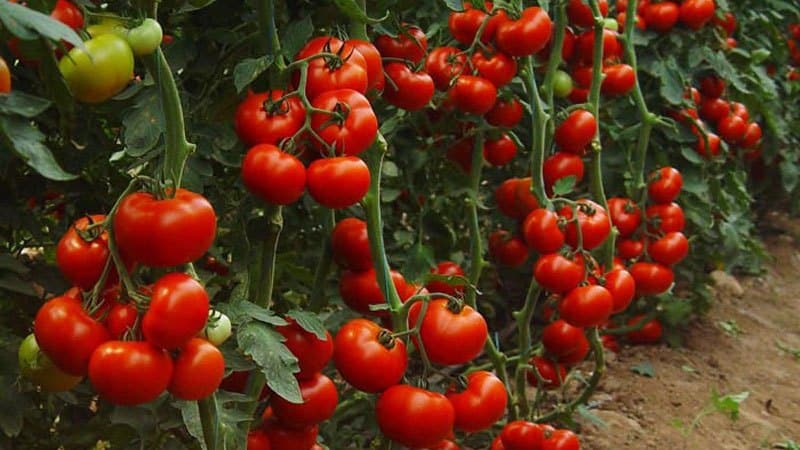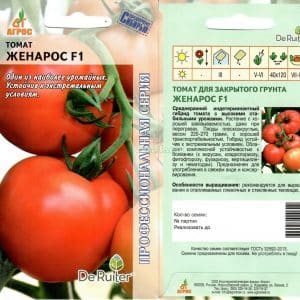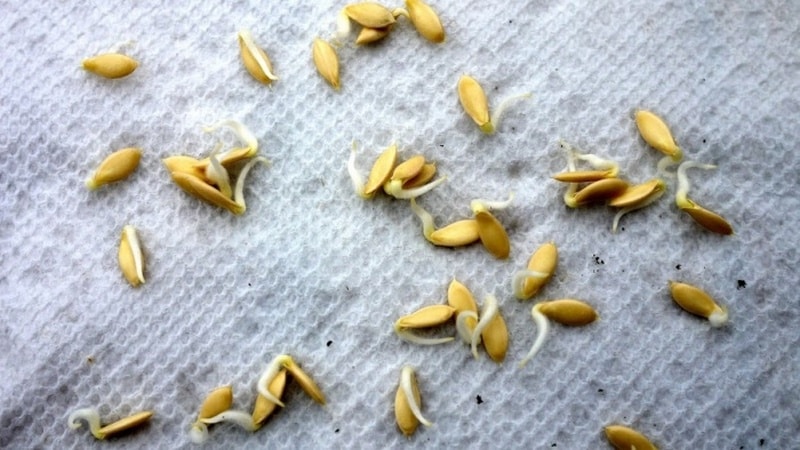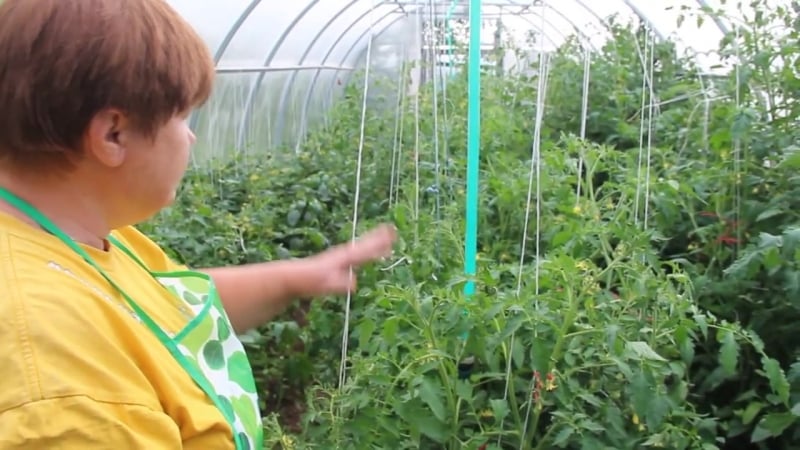Stable and easy to care for, the resilient tomato “Zhenaros” is a gift from Dutch breeders
Zhenaros F1 is a tomato hydride developed by specialists from the Dutch company DE RUITER ZODEN. In 1998, it was registered as a variety recommended for cultivation in the summer-autumn period (extended rotation is possible) in the third light zone. It was entered into the State Register of Russia in 2002 and is recommended for cultivation in the Central and Central Black Earth regions.
Description of the variety
The variety belongs to the indeterminate types of hybrids. The bush is medium leafy, medium tall. Inflorescences are simple with an intermediate structure.
Distinctive features
The plant has leaves of the usual tomato type, yellow-green in color.. The variety is mid-early, the fruits ripen a maximum of 124 days after planting in the ground. When grown in greenhouses, the bushes can produce a large harvest - 12.7 kg of fruits per 1 sq. meter of land.
The plant reaches a height of 70 cm. Russian summer residents fell in love with Zhenaros for its high stress resistance and resistance to the main diseases of the nightshade family. At the same time, the plant is unpretentious: it tolerates extremely hot weather and produces a good harvest even on depleted soil.
Fruit characteristics
The fruits of this tomato variety are different:
- flat-round or round shape;
- high density;
- glossy skin;
- a ripe tomato turns red;
- maximum weight 270 grams;
- fleshiness;
- sweetness;
- aroma.
The photo below shows fully ripe fruits.
At room temperature, fully ripened fruit can be stored for 12-14 days.At lower temperatures, shelf life increases.

Productivity
The first fully ripened fruits on the plant appear on the 100th day after planting in the ground. The maximum period for their appearance on the bush is 124 days. The minimum weight is 110-115 grams, but can reach 200-270 grams.
In open ground, the yield will be 8 kg per square meter. meters, in greenhouse conditions - 12.7 kg.
Growing seedlings
As you already understood, in order to achieve a richer harvest, it is better to grow Zhenaros tomatoes in greenhouses. But the first step is to get seedlings.

Seed preparation
Zhenaros seeds are planted for seedlings in March. Pre-sowing seed preparation consists of several stages:
- Calibration
- Warming up.
- Etching.
- Bubbling.
- Soak.
- Hardening.
- Germination.
Calibration
Select viable seeds. They should be large in size and weight, and not empty to the touch inside. It is better to discard wrinkled, crooked, flat seeds.
Selected seeds must be placed in a 1% salt solution (2.5 grams of salt per 250 milliliters of water). After 15 minutes, check: discard any grains that float to the bottom, and dry those that have sunk to the bottom of the glass.
Warming up
Place the remaining seeds on a cotton cloth, place on a cardboard on the battery and keep there for 1.5 to 2 days.
Etching
Immerse the grains in a weak (light pink) solution for 20 minutes. potassium permanganate.
This is interesting! Purchased seeds do not need to be treated against diseases - this process has already been done by manufacturers. Typically, dressing is done for tomato seeds collected from your own plot. But Zhenaros is a hybrid variety, and it is unlikely that it will be possible to grow a fruit-bearing plant from the seeds of last year’s tomatoes.
Bubbling
In simple terms - oxygen saturation.For this purpose, manual or special hardware processing is used. At home, bubbling is done like this: the seeds are placed in water heated to +26 - +30 degrees.
The water and seeds are stirred every hour for 15-18 hours. It is better not to place more than 20-30 seeds in one container. When the seeds begin to germinate, the process is stopped.
Soak
The seeds are placed in water slightly above room temperature and left for 12 hours. This step can be abandoned if bubbling is done. You can soak the seeds in special preparations - biostimulants.
“Zircon”, “Epin”, “Immunocytophyte” have proven themselves well. Soaking is carried out at an air and solution temperature of +20 degrees - in colder conditions, biostimulants stop working.
Hardening
Wrap the seeds in cloth and plastic and put them in the refrigerator (set the temperature to +2 - -3 degrees). After 8 hours, remove the seeds and leave for 8 hours at room temperature. Repeat 5-6 times.
If the region experiences short-term spring frosts, hardening will increase the plants' resistance to them.
Germination
Wrap the seeds in a layer of cloth or gauze. Place in a shallow container - saucer, lid. Moisten with water. The fabric should always remain damp. After the embryos appear, plant the seeds in the soil.
This is interesting! There is an opinion among experienced gardeners that if strong seedlings do not emerge from untreated dry seeds, then the viability and productivity of the variety will be much lower than those declared by the manufacturers.

Container and soil
Containers for planting are suitable for any shape, the soil is universal for tomatoes. You can prepare it yourself or buy it ready-made.
Components for homemade soil mixture:
- 1 part of garden land;
- 2 parts non-acidic peat (pH 6.5);
- 0.5 parts sand (river or washed);
- 1 part humus or sifted mature compost.
The soil is taken from the area where tomatoes, peppers, potatoes and eggplants have not previously grown. It’s good to add sifted wood ash (or dolomite flour), sphagnum moss and fallen pine needles.
Purchased soil should consist of:
- humus;
- peat (increases moisture supply and looseness of the soil);
- baking powder (except for peat, this is coarse river sand);
- leaf soil (mixed with other types of soil, since it has great looseness, but a small amount of nutrients).
Important! Beginner gardeners often have a question: is it necessary to steam the soil? There is an opinion that only soil prepared on your own is steamed, but it would not be superfluous to treat purchased soil.
Sowing seeds
The seeds are planted to a depth of 2 cm, watered, and covered with cellophane. In the room where the container with seeds is located, maintain a temperature of +20 degrees. After the first shoots appear, the film is removed and the container is placed on the windowsill.
Growing and caring for seedlings
After the first two true leaves appear on the seedlings, the plants are pruned - planted individually in containers. The cotyledon leaves should be near the soil.
At this stage they begin feeding tomatoes: add mineral fertilizers to the soil mixture for seedlings at the rate of 1 tbsp. spoon for 5 liters of soil. 2 weeks after picking, you can feed the tomatoes with complex fertilizer.
Transplanting to the garden
The main rule: the air temperature should be +16 – +18 degrees. Plants are planted at the age of 50-60 days.
Landing
It is recommended to harden Zhenaros tomatoes 2 weeks before planting them in the garden. To do this, boxes with seedlings are taken out onto the balcony or open veranda for several hours a day.
Plants are planted in the beds using the square-cluster method: the bushes are planted in the corners of an imaginary square, each side of which is 50-60 cm. An irrigation hole with a diameter of 40 cm is made in the center. 1 liter of ash or a handful of superphosphate and potassium sulfate is placed on the bottom, and a beveled one is placed on top. grass without seeds and rhizomes.
For reference. It is recommended to plant tomatoes in beds where cucumbers, zucchini, carrots, cauliflower, parsley, and dill previously grew.
Care
Despite the fact that Zhenaros is an unpretentious variety, there are secrets of caring for the plant that will increase its productivity.
Watering the tomatoes should be applied as the soil dries with warm water under the roots. You should not allow water to get on the leaves - this can lead to late blight.
Loosening the soil and weeding are carried out immediately after watering. If roots are visible on the stem near the ground, the plant is spudded.
At least 4-5 times during the summer they are fed with potassium-phosphorus fertilizer.
The variety belongs to tall, therefore, by stepsoning, it is formed into one stem: all stepsons are removed, 8-10 brushes are left on the main stem. Bushes tie up to pre-prepared trellises.
Diseases and pests
According to manufacturers, Zhenaros tomatoes are resistant to a whole range of diseases:
- tobacco mosaic virus;
- cladosporiosis;
- late blight;
- fusarium;
- verticillium.
Shoots extremely rarely suffer from golden nematode galls.
The nuances of growing in open ground and in a greenhouse
It is recommended to plant Zhenaros tomatoes in open beds only in regions with a hot climate.Sub-zero temperatures during spring frosts can destroy recently planted young seedlings.
In other regions, it is preferable to grow this variety in greenhouses made of both glass and film.

Important! In cool summers, it is better to remove the lower leaves to avoid rotting of the plant.
Harvesting and application
The first ovary will form after the 9th pair of leaves. On the 100th day, under favorable conditions, the first berries will begin to ripen.
Zhenaros F1 is excellent for pickling and canning; tomatoes produce high-quality purees, juices and pastes. Fresh fruits are used in vegetable salads. Shelf life is 12-14 days, after which the core dissolves.
Advantages and disadvantages of the variety
Russian summer residents love Zhenaros for its resistance to extreme conditions. In addition, tomatoes of this variety have such advantages as:
- Excellent taste characteristics.
- High commercial quality.
- Easy to care for and unpretentious.
The disadvantages include the need to tie up and feed the tomatoes.
Farmer reviews
Farmers note that Dutch tomatoes produce a good harvest in various conditions: both hot and cool summers, in open ground and in greenhouses.
Vladislav Simonov, Krasnodar: “Gennaros are good, productive, heat-resistant, but in extreme heat the taste deteriorates and they require uniform watering and fertilizers. Good for pickling, a barely noticeable core that dissolves during storage for 10-14 days.”
Valentina Ivanova, Tyumen:“Last summer I planted Zhenaros, I really liked them. I also took cuttings. I placed the tops in water, and left 2 stepsons on each stem. The fruits are smooth, red, 150 grams each. The taste is good. The ripe ones lie for a long time, the green ones I picked - they are all ripe. I live in Siberia. I planted it in a greenhouse.”
Conclusion
The Zhenaros tomato variety is suitable for growing both outdoors and in a greenhouse. Resistant to heat and drought, common tomato diseases, bears fruit well even on depleted soil. At the same time, it is unpretentious in care, does not require special skills and is suitable for growing even by inexperienced gardeners. One of the disadvantages of the variety is the need to tie up the plant and destroy the stepsons, forming a tall single-stem bush.
If all recommendations are followed, 13 kilograms of sweet, aromatic, round, red fruits weighing from 110 to 270 grams are harvested from 3-4 bushes. Tomatoes are suitable for canning, making juices and pastes, and fresh vegetable salads.